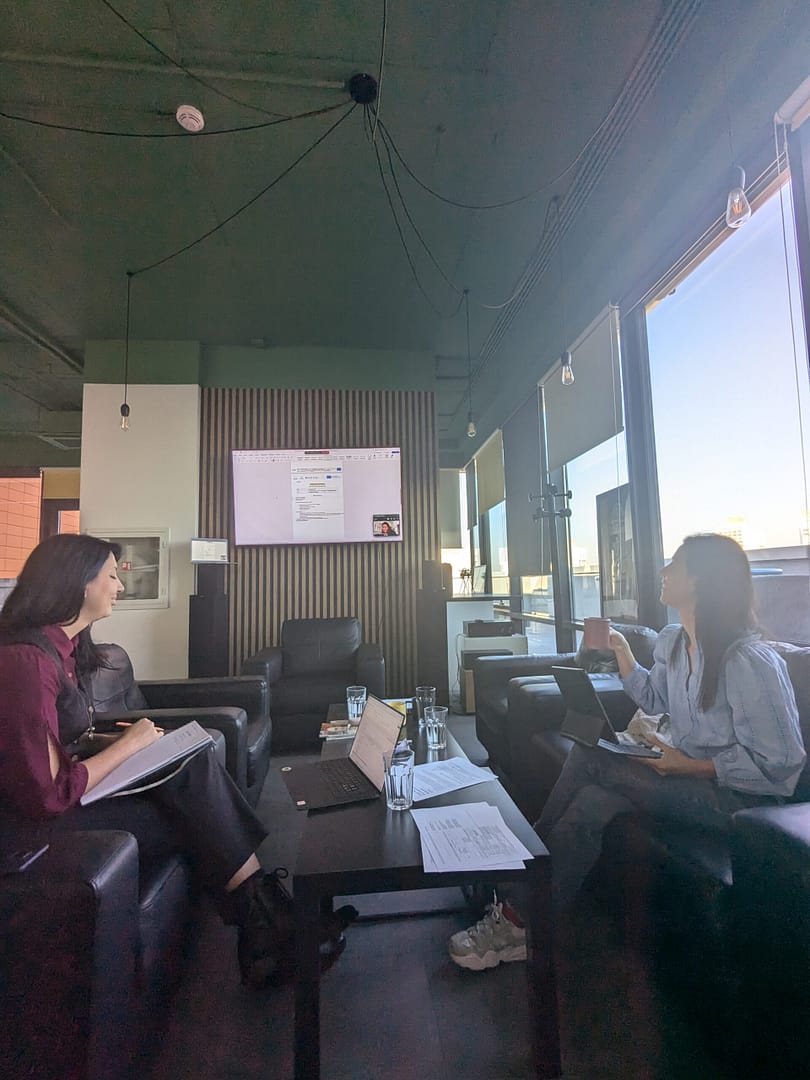Learning Outcomes:
Participants will first explore the critical role of waste reduction and re-use. They will then acquire the necessary skills and tools to effectively apply these concepts;
Duration:
3 hours
Materials needed:
Laptop/mobile device
projector/external screen
pens
papers
online evaluation form
mobile device (tablet, phone or laptop) for the participants for the practical exercise
Preparation
The first step in preparing for the upcoming session is to develop a presentation that covers the fundamental concepts of waste management, highlighting its crucial role in environmental sustainability and its positive impact on society and the planet.
Next, a key presentation will delve into the concepts of Reduce, Reuse, and Recycle. This presentation will explain each concept, offering practical examples to help participants understand how these principles can be applied in everyday life.
Following this, a presentation on “Sustainable Practices for Everyday Life” will be prepared. This presentation will showcase simple yet effective ways individuals can integrate sustainability into their daily routines, providing actionable tips and encouraging more environmentally friendly habits.
In addition to preparing the presentations, the room will be arranged to ensure a comfortable and conducive learning environment for all participants. This includes setting up seating, testing any necessary equipment, and creating an atmosphere that promotes engagement and interaction.
Finally, an online evaluation form will be created for participants to complete after the session. This form will be designed to gather feedback on the activity, assessing its effectiveness and identifying areas for improvement in future sessions.
Description
In the second session of the module, the trainer will build directly upon the previous activity, ensuring a seamless transition into the new material by connecting the group’s earlier discussions with the content to be covered.
To begin, the trainer will present the Learning Objectives (LOs) and the agenda for the session, setting clear expectations and outlining the key topics that will be explored.
The session will then proceed with a brief, 5-minute(recommended time) presentation on “Waste Management”. This segment will include a concise definition of waste management, followed by an explanation of its importance and the various benefits it offers, such as reducing environmental impact and promoting sustainability.
Next, the trainer will deliver a 5-minute(recommended time) presentation on “Understanding the 3Rs”. This presentation will define the concepts of recycling, reducing, and repurposing, accompanied by relevant examples to illustrate each. The importance of the 3Rs in managing waste and conserving resources will also be emphasized, helping participants understand how these principles contribute to a more sustainable future.
The session will conclude with a 5-minute presentation(recommended time) on “Sustainable Practices for Everyday Life”. The trainer will start by defining what sustainable practices are and then present at least eight practical examples. Each example will be discussed in terms of its significance and how it can be incorporated into daily routines to promote sustainability.
This carefully structured session is designed to reinforce the participants’ understanding of waste management, the 3Rs, and sustainable practices, ensuring they leave with practical knowledge they can apply in their everyday lives.
Practical exercise:
- After the theoretical component, participants will engage in a hands-on group exercise designed to apply their understanding of sustainability concepts in real-world scenarios. This exercise will last for 2 hours and 20 minutes.
- To start, the participants will be divided into groups of four. The trainer will explain that each group is tasked with designing and presenting two initiatives:
- Initiative 1: Focus on “Reuse” in the Local Community
The first initiative requires each group to focus on the concept of “reuse” within their local community. The objective is to encourage the reuse of one of the following items:
- Clothes
- Household objects
- Broken household objects
Each group will be assigned one of these items and must design an initiative aimed at promoting its reuse.
- Initiative 2: Focus on “Waste Prevention” in Personal and Household Activities
For the second initiative, each group will focus on “waste prevention” that can be implemented within a household or through daily activities. The aim is to encourage reuse as a means of waste prevention in one of the following areas:
- Preventing food waste
- Preventing packaging waste
- Preventing unnecessary printing and receipt of letters or promotional materials
Again, each group will be assigned one of these areas and must design an initiative aimed at reducing waste.
- Groups will have 1 hour and 45 minutes to develop their presentations. Each presentation must include the following structure for both initiatives:
- Designed Initiative 1:
- Name of the initiative
- Motto or slogan
- Target community
- Description: What is the initiative? How can it be used? What is its purpose?
- Promotion Strategies: How will the initiative be promoted within the local community?
- Designed Initiative 1:
- Designed Initiative 2:
- Name of the initiative
- Motto or slogan
- Target community
- Description: What is the initiative? How can it be used? What is its purpose?
- Promotion Strategies: How will the initiative be promoted within the local community?
- Designed Initiative 2:
- During the exercise, the trainer will:
- Provide the structure of the presentation exercise, displaying it on a projector for continuous reference.
- Offer support by answering participants’ questions and clarifying any misunderstandings.
- Observe group dynamics to ensure all participants are actively contributing to the work and presentations.
- After the 1 hour and 45 minutes, the groups will reconvene in a plenary session to present their initiatives. Each group’s presentation will last between 5 to 10 minutes, depending on the number of groups. Following each presentation, the audience will provide feedback and offer tips to the presenting group, fostering a collaborative and constructive environment.
The session will conclude with a 15-20-minute debriefing, see below the details.
Debriefing
After the practical exercise, the session transitions into a learning check and debriefing phase.
Presentation and Debriefing
As part of the learning check, participants will present the outcomes of their practical exercise. During this time, the trainer will guide the discussion by asking questions (see below) in order to summarize the key takeaways from both the theoretical presentations and the hands-on activity.
Debriefing Questions:
To facilitate reflection, the trainer will pose the following questions to the group:
- What were the key takeaways from the presentations on waste management, the 3Rs, and sustainable practices?
- Were there any concepts or terms that were unclear or need further explanation?
- Which of the concepts (waste management, the 3Rs, or sustainable practices) do you find most relevant to your daily routines?
- Can you think of any situations where you can apply the principles of waste management and the 3Rs in your community?
- How innovative were the initiatives your group designed? Do you believe they can make a real impact in the community?
- Were there any particular strategies or ideas that your group found especially effective in promoting reuse or waste prevention?
- How did your group handle the presentation of your initiatives? Did you feel prepared and confident?
- How valuable was the feedback from the audience? What insights did you gain that could improve your initiatives?
Q&A and Group Discussion
The session will then move into a Q&A and group discussion, providing an opportunity for participants to engage in a deeper conversation about the exercise and the activity as a whole. This discussion allows for the exchange of ideas, clarification of any uncertainties, and further exploration of the topics covered.To facilitate reflection, the trainer will pose the following questions to the group:
- Was the time allotted (1 hour and 45 minutes) sufficient for developing your initiatives?
- What improvements could be made to the structure of the practical exercise to enhance learning and engagement?
- What surprised you?
- What do you know now that you didn’t know before?
- What adjective would you use to define this experience?
- Describe what you experienced during this experience.
Evaluation and Feedback Collection
Participants will be asked to complete an online evaluation form, providing valuable feedback on the session. This feedback will help the trainer assess the effectiveness of the activity and identify areas for improvement.
Tips
The trainer must possess a deep and thorough understanding of the topic at hand. This expertise forms the foundation upon which the training is built, ensuring that the content delivered is both accurate and insightful.
The trainer should begin promptly, introducing themselves to the participants with a warm and welcoming demeanour. This initial introduction sets the tone for the session and establishes a rapport with the attendees.
Following this, the trainer must clearly outline the objectives and agenda of the session, providing a roadmap for what participants can expect to learn and accomplish.
Engagement is crucial throughout the session. The trainer should actively involve participants through thoughtful questions and interactive discussions. This approach helps maintain interest and encourages deeper understanding by prompting participants to reflect on and discuss the material being presented.
Ensuring that all participants are actively engaged and grasp each element of the training process is a fundamental responsibility of the trainer. It is not enough for the trainer to present the material; they must also verify that participants are following along and understanding the content.
Finally, the trainer will gather feedback to assess the effectiveness of the training session. This feedback is collected through online evaluation forms and a debriefing process. Analysing this feedback allows the trainer to refine their approach and improve future sessions, ensuring continuous enhancement of the training experience.
The trainer will keep on the screen the details of the exercise. While pens and paper will be available if needed, the trainer, emphasizing the project’s green initiative, will encourage participants to use their mobile devices for note-taking and to complete the practical exercise
Handouts and resources
What is waste management?
The 3 R’s of the environment explained
Exploring the 3Rs of the waste management
Ways to live more sustainable
The trainer(s) can use these handouts for the session or create their own, as long as the same basic concepts are included (waste management, sustainable practices for everyday life , the 3Rs in waste management ).
More To Explore
Co-Design Processes and Methodologies
Learning Objectives (LOs)
Mentoring methodologies and strategies
Learning Objectives (LOs)


